

THE NEGRO MOTORIST GREEN BOOK
guided Black Americans to thousands of businesses for over thirty years.

When the first Green Book was published, the American road was a metaphor for freedom.
Yet, in 20th century America, this same road was a dangerous place for Black citizens.
The land was divided by segregation—through policy or through custom. If you were Black, the prejudice was severe: a systematic effort to deny access to your basic human rights.
The landmark 1896 Supreme Court decision, Plessy v. Ferguson, created a legal precedent for the separation of Americans by race.
The resulting policies constructed an intricate system of rules and regulations that disempowered Black people and subjected them to constant harassment.
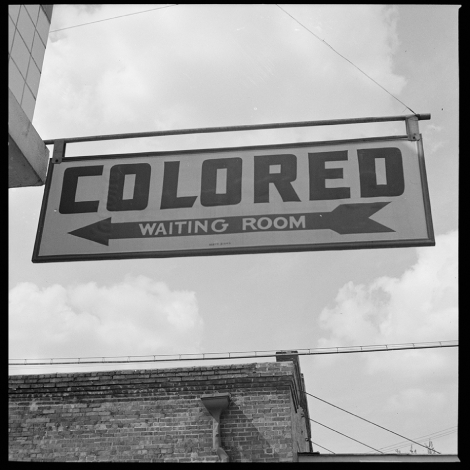
“ I looked in my rear view mirror and there was a guy in Klan outfit approaching me from the back. Full Klan outfit. The face was cutout. I could see his face, and it was right at dusk dark.
And I said to myself,‘ What can I do?’”
- Curtis Graves, former Texas state legislator and NASA Director of Civil Affairs

Man in Car Flirting with Woman, ca. 1955. Charles "Teenie" Harris. Collection of the Smithsonian National Museum of African American History and Culture. Gift from Charles A. Harris and Beatrice Harris in memory of Charles "Teenie" Harris. (c) Carnegie Museum of Art, Charles "Teenie" Harris Archive.

[Side View Outdoor Smiling African American Family Father Mother Two Sons Sitting in Four Door Sedan], 1950s. H. ARMSTRONG ROBERTS/ClassicStock.

[Four-young African American women standing beside a convertible automobile], ca. 1958. WANN Radio Station Records, Archives Center, National Museum of American History, Smithsonian Institution.

[Negro boys on Easter morning. Southside, Chicago, Illinois], 1941. Russell Lee. Farm Security Administration/Office of War Information Photograph Collection, Prints & Photographs Division, Library of Congress, LC-DIG-ppmsc-00256.
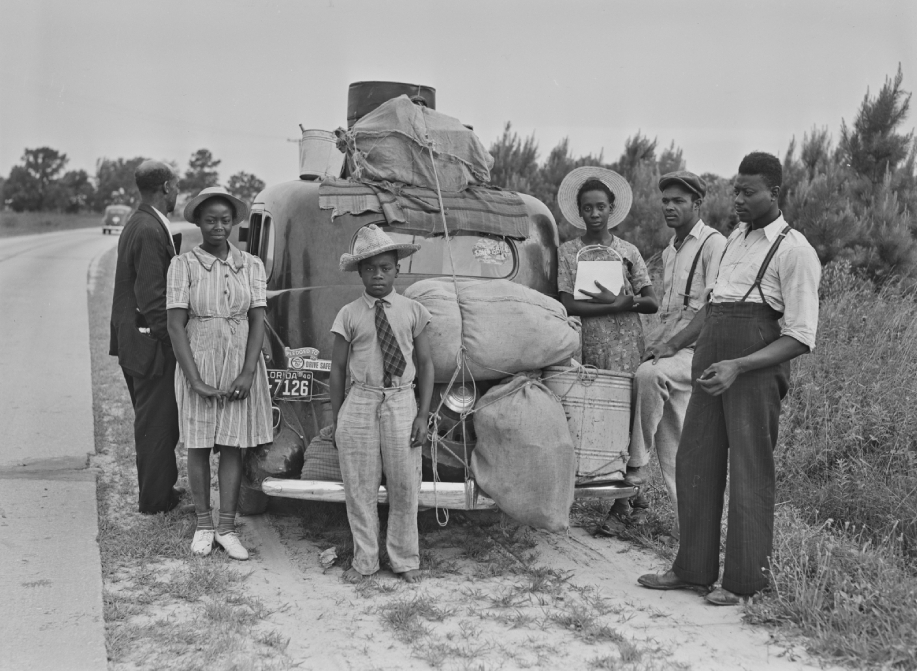
[Group of Florida migrants on their way to Cranberry, New Jersey, to pick potatoes, near Shawboro, North Carolina], 1940. Jack Delano. Farm Security Administration/Office of War Information Photograph Collection, Prints & Photographs Division, Library of Congress, LC-DIG-fsa-8c02701.
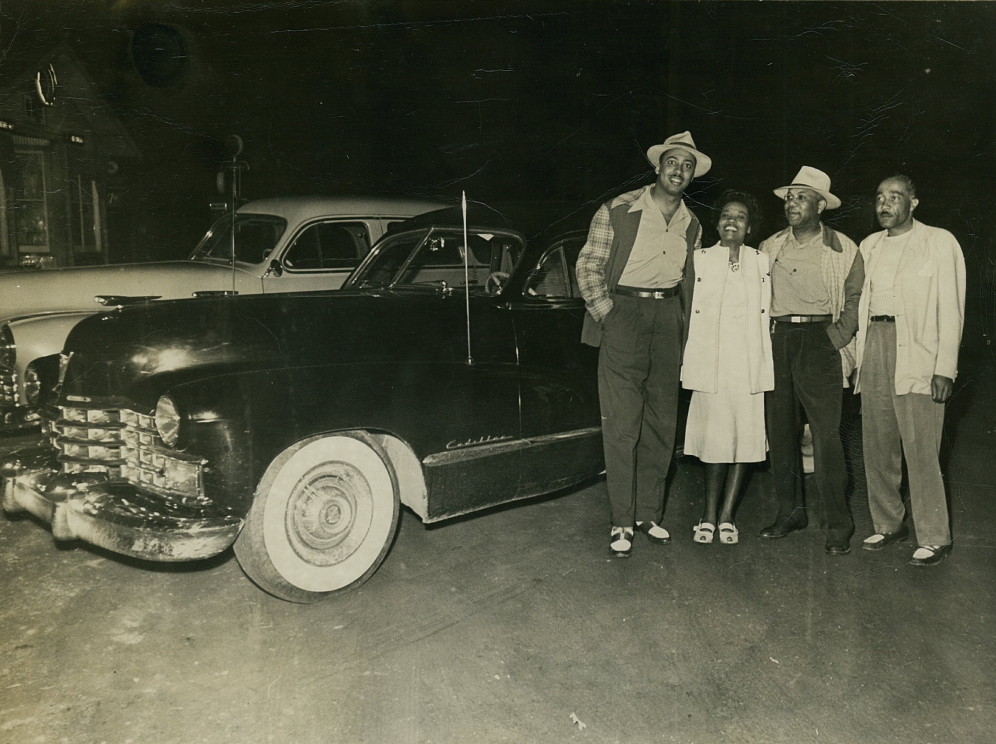
[Travelers in front of a Cadillac]. Lake County Historical Society, Baldwin, Michigan.
The American proclamation of freedom has always been intertwined with travel .

By the 1930s, there were nearly thirty million cars on the road, and 85% of Americans vacationed by car. Significantly, the car industry created a new path to prosperity for Black Americans. In a Jim Crow world, where policy limited access to affordable housing and neighborhoods of choice, having a car opened your world. It was a prized possession, as thrilling as it was useful. It was a portal to humanity, from work and family functions to household needs and leisurely getaways. Credit: The Travelers' Green Book , 1960. Schomburg Center for Research in Black Culture, Manuscripts, Archives, and Rare Books Division, The New York Public Library.
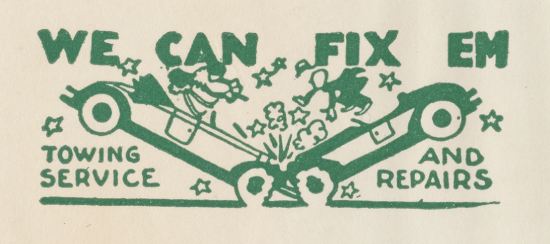
Credit: The Negro Motorist Green Book, 1947. Schomburg Center for Research in Black Culture, Manuscripts, Archives, and Rare Books Division, The New York Public Library.
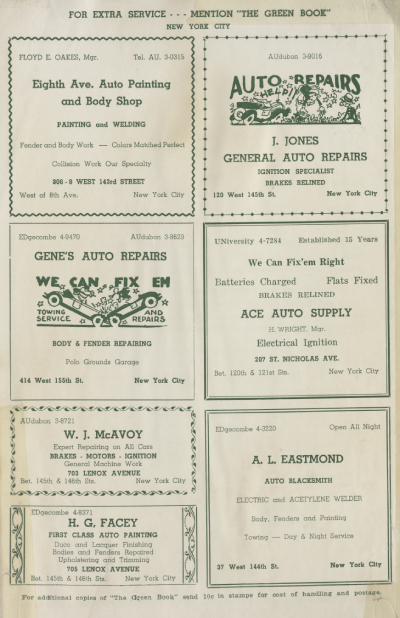
“The automobile has been a special blessing to the Negro.”—The Negro Motorist Green Book, 1938 edition Credit: The Negro Motorist Green Book, 1937. Schomburg Center for Research in Black Culture, Manuscripts, Archives, and Rare Books Division, The New York Public Library.

Mechanics could earn as much as $25 to $50 a week. Many Black men migrated to northern cities to earn these higher wages, ensuring a better standard of living—enabling many the opportunity to buy a car of their own. Credit: [Auto mechanic Sam "Scotty" Scott], ca. 1944. Charles "Teenie" Harris. Collection of the Smithsonian National Museum of African American History and Culture, Gift from Charles A. Harris and Beatrice Harris in memory of Charles "Teenie" Harris, (C) Carnegie Museum of Art, Charles "Teenie" Harris Archive.
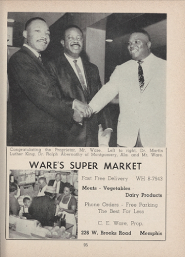
Since legal enslavement, financial independence has been critical to Black liberation in America. The Green Book would not have been possible if not for the community of self-sufficient, talented, and successful Black businesses that filled its pages. Dr. Martin Luther King Jr., on the left, understood the significance of Black businesses to Black civil rights. Credit: The Travelers' Green Book, 1960. Schomburg Center for Research in Black Culture, Manuscripts, Archives, and Rare Books Division, The New York Public Library.
Click on the images to learn more information
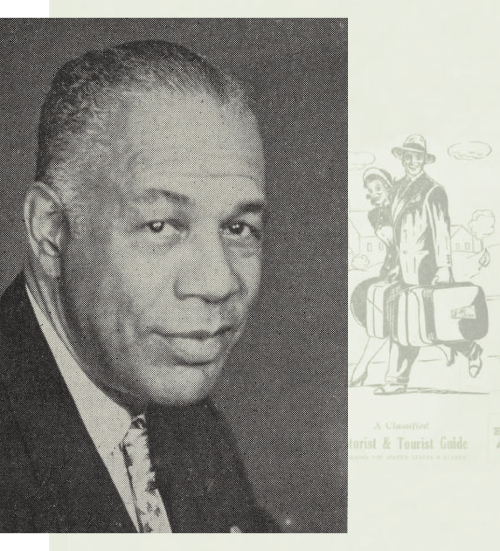
He was a postal worker. He was an entrepreneur. He was an innovator.
Victor Green lived in the famed Sugar Hill community in Harlem, New York. Until his retirement in 1952, Victor Green was a full-time letter carrier for the U.S. Post Office five days a week. When he created the Green Book, he enlisted his fellow postmen to make contact with Black entrepreneurs along their routes, and invite them to list in the Green Book as well as sell the guide to travelers.
The Negro Travelers' Green Book, Fall 1956. & The Negro Motorist Green Book, 1948. Schomburg Center for Research in Black Culture, Manuscripts, Archives, and Rare Books Division, The New York Public Library.
The 1947, 1948, 1955, 1956, and 1960 covers of the Green Book, NYPL Digital Collections
Navigating The Green Book
The Green Book was a travel guide published between 1936 and 1966 that listed hotels, restaurants, bars, gas stations, etc. where black travelers would be welcome. NYPL Labs is in the process of extracting the data from the Green Books themselves and welcomes you to explore its contents in new ways.
Visualize a trip using the Green Books
View a map of the data extracted from the Green Books
An Introduction
Victor Green, The Negro Travelers' Green Book: Fall 1956
From Schomburg Treasures: The Green Book by K Menick of Schomburg Center for Research in Black Culture :
From 1936 to 1966, Victor Green, a postal worker who worked in New Jersey but lived in Harlem, published the directories known today as the Green Book . (The actual titles were variously: The Negro Motorist Green Book; The Negro Travelers' Green Book; The Travelers' Green Book .) These listed hotels, restaurants, beauty salons, nightclubs, bars, gas stations, etc. where Black travelers would be welcome. In an age of sundown towns, segregation, and lynching, the Green Book became an indispensable tool for safe navigation.
We encourage you to explore these books; map them in your mind. Think about the trips you could take, can take, will take. See how the size of the world can change depending on the color of your skin.
Map A Trip With Green Books View Green Book Map
The Collection
The New York Public Library's Schomburg Center for Research in Black Culture has digitized 21 volumes of the Green Books from 1937 to 1964 .
From the Introduction to the 1949 edition :
With the introduction of this travel guide in 1936, it has been our idea to give the Negro traveler information that will keep him from running into difficulties, embarrassments and to make his trips more enjoyable.
If this guide has proved useful to you on your trips, let us know. If not, tell us also as we appreciate your criticisms and ideas in the improvement of this guide from which you benefit.
There will be a day sometime in the near future when this guide will not have to be published. That is when we as a race will have equal opportunities and privileges in the United States. It will be a great day for us to suspend this publication for then we can go wherever we please, and without embarrassment. But until that time comes we shall continue to publish this information for your convenience each year.
According to legal research done by NYPL staff, those 21 volumes have no known US copyright restrictions, and can be used and reused freely.
The NYPL Labs has extracted the text and coordinate data (via OCR ) from the high-resolution images of The Negro Motorist Green Book: 1947 . The Scribe framework was then used to correct and normalize the data generated from the OCR processing.
The data from The Negro Travelers' Green Book: Spring 1956 was provided by the Green Book map created by the SC Digital Academy and the Digital Collections and African American Studies departments of the University of South Carolina.
- Paul Beaudoin - Data wrangling, geocoding, human API
- Brian Foo - Interface design and development
- Josh Hadro - OCR processing
- Matt Miller - OCR processing, data wrangling
- Schomburg Center for Research in Black Culture - Collection curation, advising
- SC Digital Academy and the Digital Collections and African American Studies departments of the University of South Carolina - Data provider
Schomburg Treasures: The Green Book
The Negro Motorist Green Book, 1947
" Carry your Green Book with you—you may need it ."
The mid-20th Century: a time of freedom and grand opportunities. Ever bigger and faster and cheaper cars allowed an exciting ease of movement across America's new parkways, numbered highways, and interstates. The automobile changed the world, and suddenly the horizon seemed to go on forever. But some other essential changes were a long time coming, and for one segment of the population that horizon was filled with landmines .
Enter Victor Green . From 1936 to 1966 (with only a pause for WWII), this postal worker from New Jersey published the directories known today as the Green Book. (The actual titles were variously: The Negro Motorist Green Book; The Negro Travelers' Green Book; The Travelers' Green Book .) These listed—first in NYC only, later throughout much of the world—hotels, restaurants, beauty salons, nightclubs, bars, gas stations, etc. where black travelers would be welcome. In an age of sundown towns, segregation, and lynching, the Green Book became an indispensable tool for safe navigation.
Victor's introductions always concluded:
There will be a day sometime in the near future when this guide will not have to be published. That is when we as a race will have equal opportunities and privileges in the United States. It will be a great day for us to suspend this publication for then we can go wherever we please, and without embarrassment. But until that time comes we shall continue to publish this information for your convenience each year.
He continued publication until just after the passage of the Civil Rights Act of 1964 .
But the story doesn't end there. To flip through a Green Book is to open a window into history and perhaps to see, the tiniest amount, through the eyes of someone who lived it . Read these books; map them in your mind. Think about the trips you could take, can take, will take. See how the size of the world can change depending on the color of your skin.
The Schomburg's full collection is available here .
Green Book Research Guide: The Green Book Digital Collections
- The Green Book Digital Collections
- Web Resources
- Journal Articles
- Theses / Dissertations
- Historical Newspapers
- Hackley & Harrison's Guide for Colored Travelers (1930)
- Afro-American's Travel Guide (1939)
- Travelguide (1946)
- Go, Guide to Pleasant Motoring (1952)
- The Black American Travel Guide (1971)

The Green Book: NYPL Digital Collections

Visit The New York Public Library's Digital Collections to view issues of the Green Book.
Related NYPL Digital Resources

- << Previous: Welcome
- Next: Web Resources >>
- Last Updated: Aug 25, 2023 4:30 PM
- URL: https://libguides.nypl.org/greenbook
- Skip to global NPS navigation
- Skip to the main content
- Skip to the footer section

Exiting nps.gov
Green book properties listed in the national register of historic places.
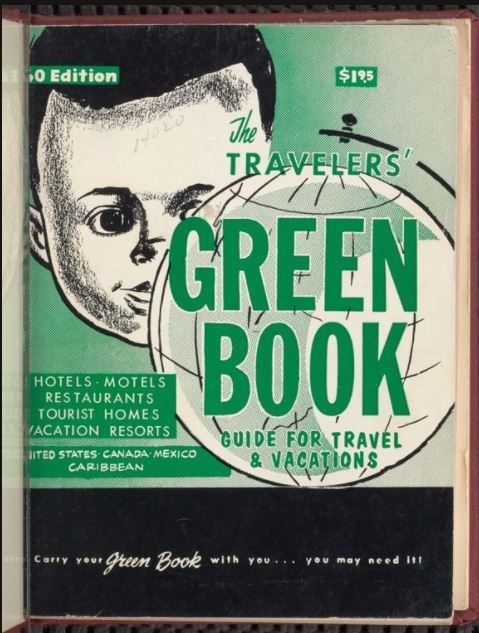
Schomburg Center for Research in Black Culture, Manuscripts, Archives and Rare Books Division, The New York Public Library. "The Travelers' Green Book: 1960" New York Public Library Digital Collections. https://digitalcollections nypl.org
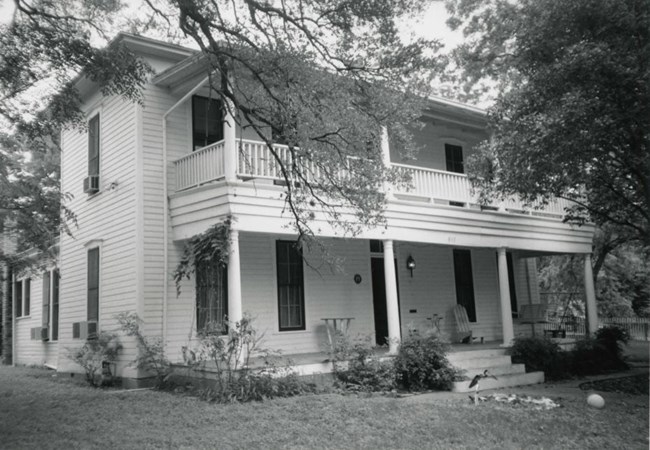
Photograph by Apama Surte, courtesy of Texas State Historic Preservation Office
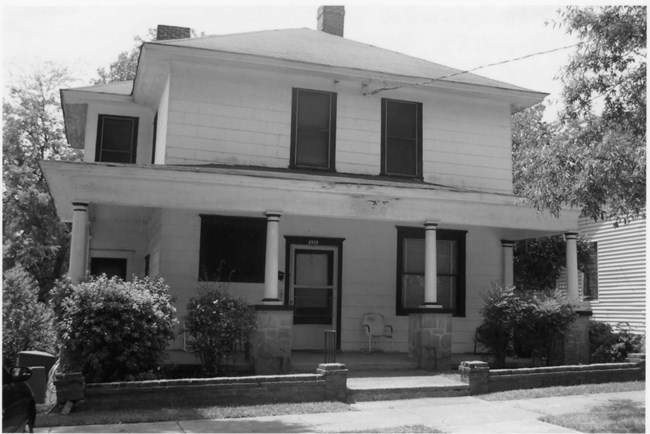
Photograph by Andrew W. Chandler, courtesy of South Carolina Historic Preservation Office
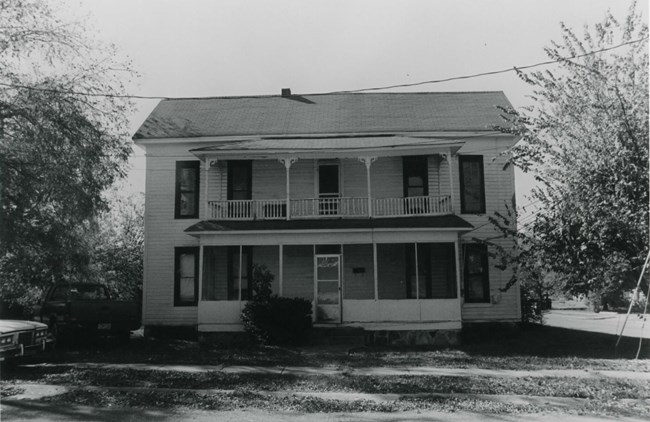
Photograph by Ralph S. Wilcox, courtesy of Arkansas Historic Preservation Office
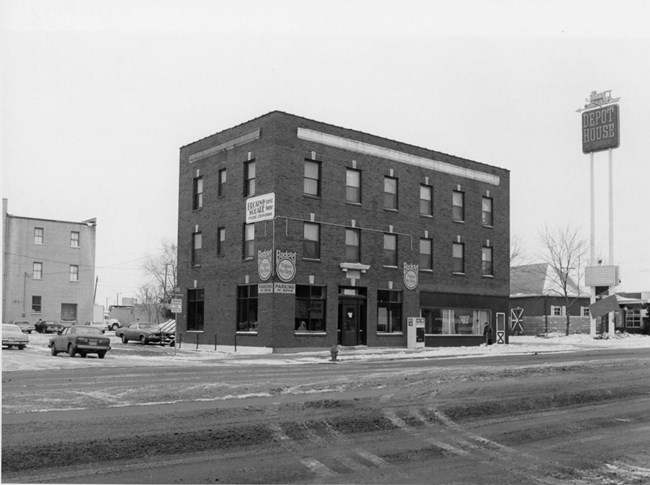
Photograph by Robert Frame III, courtesy of Minnesota State Historic Preservation Office
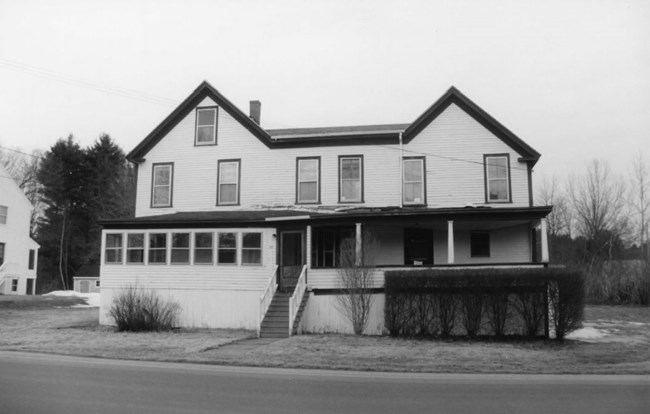
Photograph by Christi A. Mitchell, courtesy of Maine State Historic Preservation Office
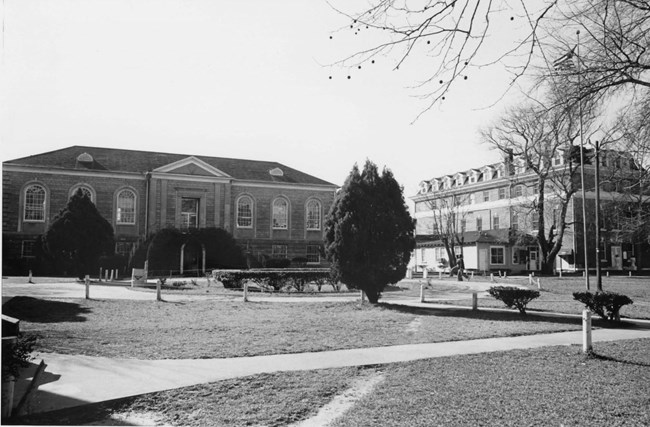
Photograph courtesy of South Carolina State Historic Preservation Office
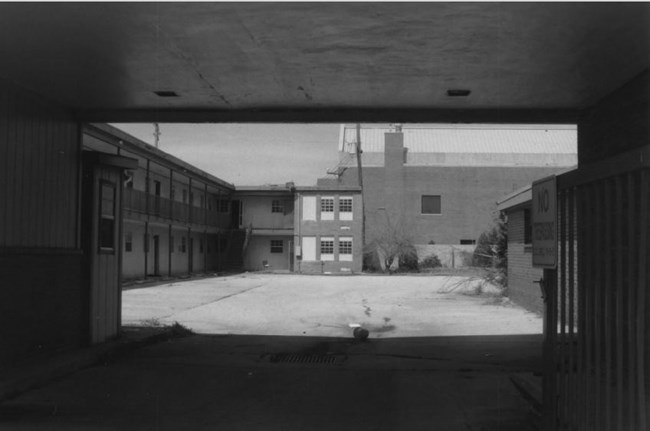
Photograph by Courtney Mooney, courtesy of Alabama Historic Preservation Office
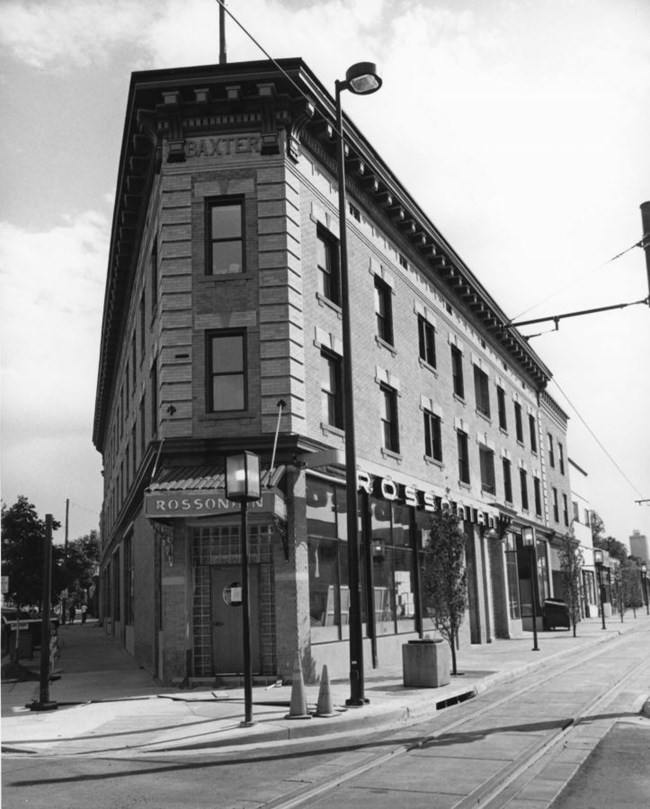
Photograph by Nancy Lyons, courtesy of Colorado State Historic Preservation Office
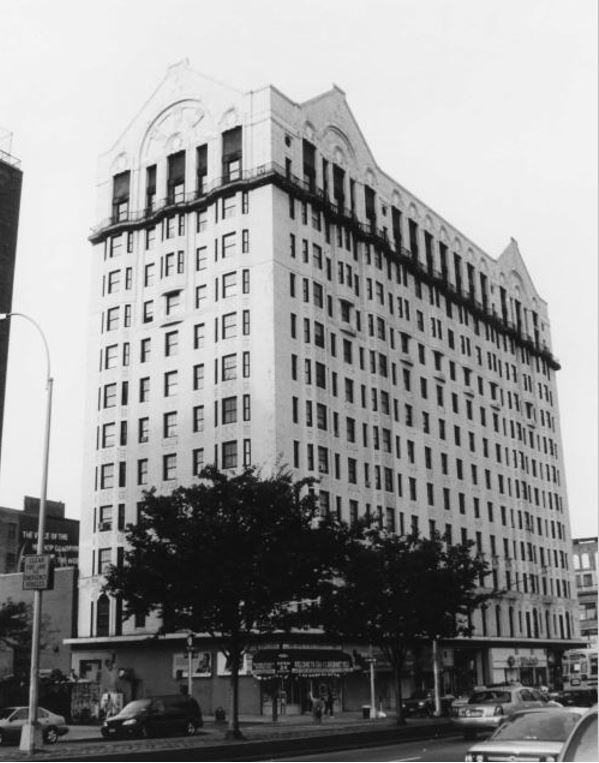
Photograph by Anthony Robins, courtesy of New York Historic Preservation Office
Photograph by William Maclane Hull, courtesy of the South Carolina State Historic Preservation Office
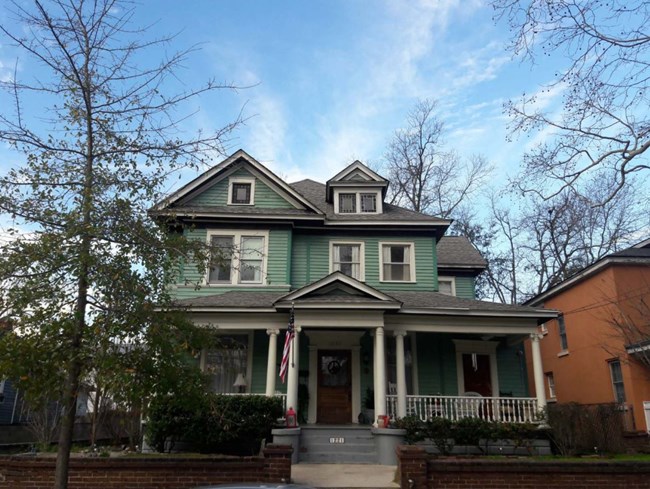
Photograph by Carlie N. Todd, courtesy of South Carolina Historic Preservation Office

Photograph by Ramon Jackson and Holly Floyd, courtesy of South Carolina State Historic Preservation Office
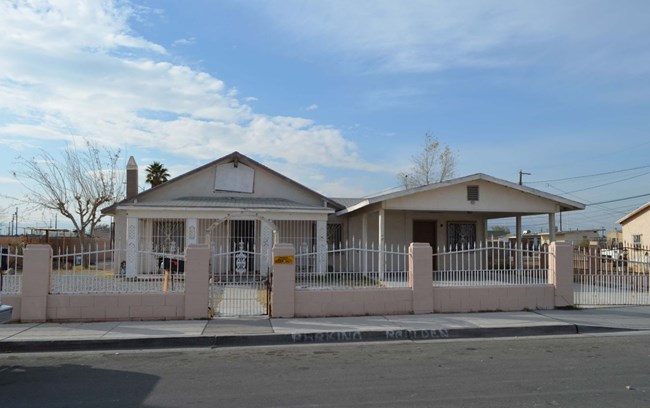
Photograph by Courtney Mooney, courtesy of Nevada Historic Preservation Office
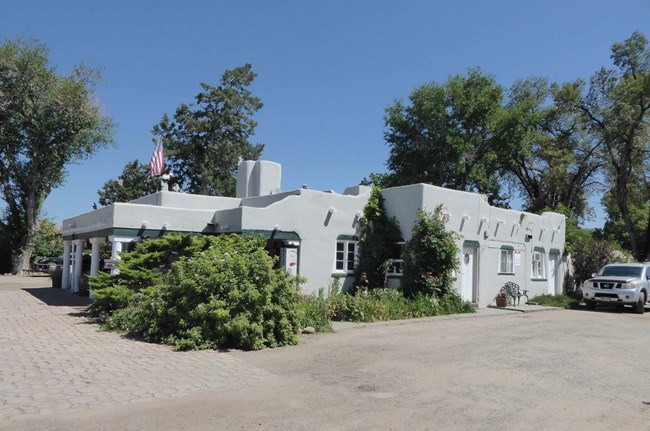
Photograph by Thomas H. Simmons, courtesy of Colorado State Historic Preservation Office

Photograph by Craig Leavitt, courtesy of Colorado State Historic Preservation Office
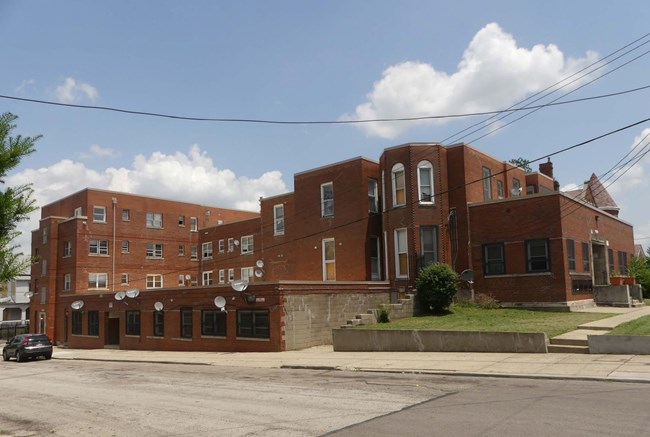
Photograph by Rory Krupp, courtesy of Ohio State Historic Preservation Office
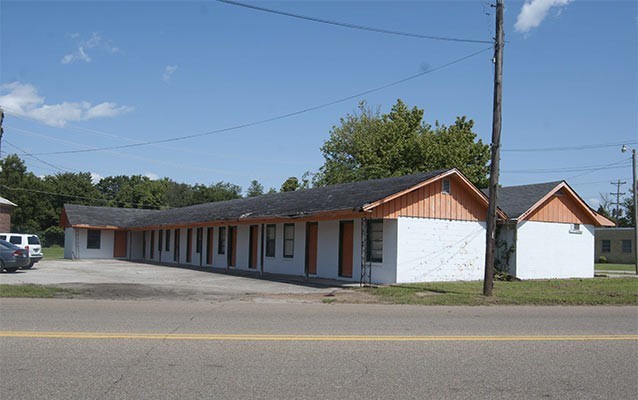
Photograph by Holly Barnett, courtesy of Tennessee State Historic Preservation Office
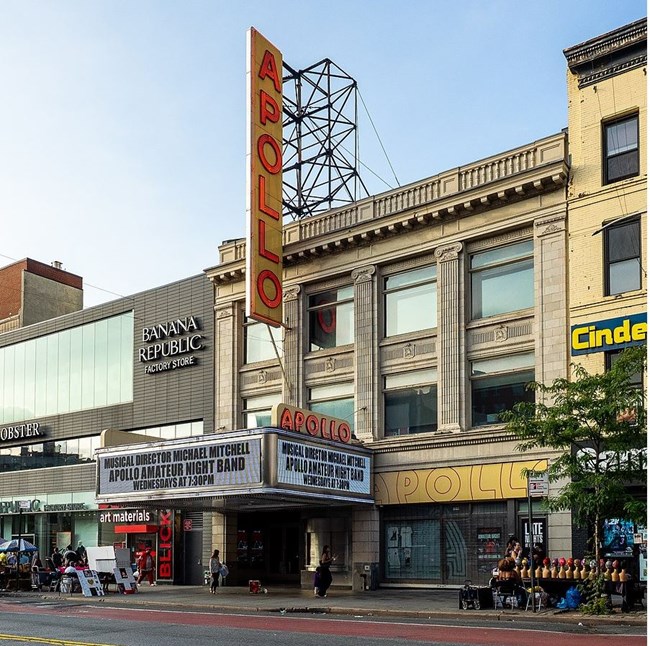
Photograph by Ajay Suresh, Harlem - Apollo Theater, cc-by-2.0
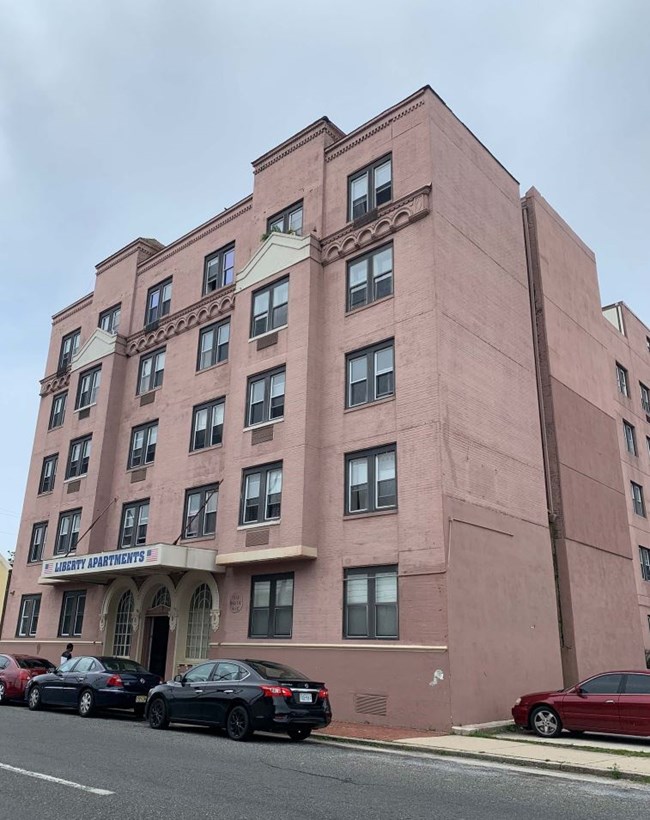
Photo by Corinne Engelbert & Marcio Tavares, courtesy of New Jersey State Historic Preservation Office

Matthew T Rader, MatthewTRader.com, License CC-BY-SA
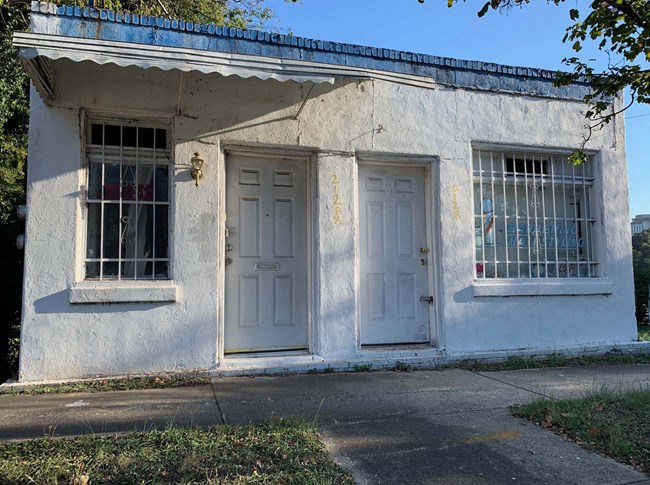
Photograph by Caitlin Cutrona, courtesy of South Carolina State Historic Preservation Office
- Chappelle Tourist Home (Waverly Historic District)
- Hilltop Hotel (Harper’s Ferry Historic District)
- Lewis Clark Hotel (Lewiston Historic District)
- North Carolina Green Book Sites
- North Carolina African American Heritage Commission
- Tennessee Green Book Sites
- Virginia Green Book Sites
- South Carolina Green Book Sites
- South Carolina Green Book Project
- Connecticut Green Book Sites
- Texas Green Book Project
- South Dakota Green Book Sites
- Utah Green Book Project
- Vermont Green Book Sites
- Smithsonian Green Book Project
- National Park Service
- National Trust for Historic Preservation
- National Museum of African American History & Culture
- New York Public Library Digital Collection
- Mapping “The Green Book”
- Overground Railroad: The Green Book
- Information for the article was compiled from the National Trust for Historic Preservation and the Smithsonian Green Book Project.
- The Green Book Properties Listed in the National Register of Historic Places was researched and compiled by National Council for Preservation Education intern Alicia Guzmán.
You Might Also Like
- green book sites
- african american history
- african american history and culture
- african american civil rights network
- smithsonian institution
- black history
- jim crow era
- travel guide
Last updated: May 5, 2022

Friends of the Library
Help the library by becoming a friend.
Would you like to be our Friend?
Everyone's a friend of the library, but why not formalize the relationship? If you value books and reading, you're invited to join us in our endeavors.
2024 Book Sales
Stephens Central Library: Basement 9 am - 1 pm
Saturday, March 2, 2024
Saturday, May 4, 2024
Saturday, July 13, 2024
Saturday, September 7, 2024
Saturday, November 2, 2024
Cash and card accepted Carryout available
Larry Justiss Book Store
@stephens central.
In addition to bi-monthly sales, volunteers of the Friends of the Library operate the Larry Justiss Book Store in the Stephens Central Library. You will find every genre you can imagine, plus a specially curated Gift Collection, and a Texana and local-authors section.
.jpg)
History, Mission, and Membership
Organized in 1979, Friends of the Tom Green County Library, Inc. was established to promote use of the Library and its many services through donations and various projects. The Friends were a motivating force behind the construction of Angelo West Branch Library and have donated substantially to the North Branch Library expansion. Working with County Commissioners and Library Administration, the Friends provide strong leadership in bringing Tom Green County residents exceptional library services.
Bi-monthly Book Sale
One of our most popular projects is the bimonthly, first-Saturday book sale, held in our headquarters at Stephens Central. These sales raise thousands of dollars for the library each year. Additionally, our volunteers manage and operate a book store in Stephens Central.
Purchase Books Online

Proceeds are used to strengthen the library collection and sponsor programs and activities that enhance use of the Library and encourage reading.
Membership Dues
We invite your support. The cost is little; the rewards immense. Fees are as follows:
Individual: $10.00 a year Family: $25.00 a year Individual Lifetime: $150.00 Family Lifetime: $300.00
Apply for Membership
Becoming a Friend is easy. Just fill out the application (also available at all libraries) and mail with payment to:
Friends of the Library P.O. Box 60421 San Angelo, TX 76906
Support the Friends
You can also support us with your purchases through Amazon. Visit Amazon Smile for more information and to choose the recipient of your charitable giving.
For more information on membership or volunteer opportunities, contact the Friends at [email protected] or stop by the book store at Stephens Central to talk with a Friend.
- Newsletters
Site search
- Israel-Hamas war
- Home Planet
- 2024 election
- Supreme Court
- All explainers
- Future Perfect
Filed under:
- Awards Shows
- Green Book builds a feel-good comedy atop an artifact of shameful segregation. Yikes.
The movie is named after guides published for black travelers in segregated America. But its spin is all Hollywood.
Share this story
- Share this on Facebook
- Share this on Twitter
- Share this on Reddit
- Share All sharing options
Share All sharing options for: Green Book builds a feel-good comedy atop an artifact of shameful segregation. Yikes.
/cdn.vox-cdn.com/uploads/chorus_image/image/62345225/greenbook1.0.jpg)
Green Book took home three Golden Globe Awards on Sunday for Best Comedy, Best Screenplay, and supporting actor Mahershala Ali — and that’s hardly a surprise. A period piece that’s also a road trip movie and a buddy dramedy? Based on a true story? With two strong performances and a heartwarming message about overcoming prejudice? That ends at a Christmas celebration? Sign America up (or at least the Hollywood Foreign Press Association).
The film, directed by comedy veteran Peter Farrelly , stars Viggo Mortensen and Ali. It’s “inspired” by the true friendship of Tony Vallelonga, an Italian-American chauffeur/bodyguard from the Bronx, and Don Shirley, the black pianist Vallelonga is hired to drive and protect on a concert tour through the deep South in 1962. It’s often funny, with some poignant moments and a heart that feels like it’s in the right place.
Yet curiously, the Green Book itself doesn’t play much of a role in the film. Mortensen’s character, Tony, takes it on the trip and leafs through it several times. Early on, he briefly explains its purpose to his wife Delores (Linda Cardellini): to provide black travelers with information about “safe” places to stay and to eat while they travel. He’ll need to refer to it to do his job, getting Shirley from gig to gig safely throughout the musician’s eight-week tour.
:no_upscale()/cdn.vox-cdn.com/uploads/chorus_asset/file/13448090/greenbook3.jpg)
But after that, the book is not mentioned by name, even as the pair encounter the full gamut of racism during the trip — ranging from casual remarks to “genteel” discrimination to violent hostility from civilians, bar patrons, and police. Indeed, we typically see it only when Tony quietly picks it up to find motels in which Shirley can safely stay.
When Farrelly took the stage to accept the Golden Globe for Best Comedy or Musical, he used the opportunity to reiterate the film’s themes (and demand that the orchestra not play him off):
Green Book is a story of a trip that — [ to the orchestra ] please, no, turn that off. No, go away. Off. Okay. This is a story of the trip that Don Shirley took in the pre-Civil Rights era of the 1960s. Don Shirley was a great man and underappreciated genius who couldn’t play the music he wanted to play, simply because of the color of his skin. Yet he went on to create his own music that still resonates to this day. ... This story, when I heard it, gave me hope, and I wanted to share this hope with you. Because we are still living in divided times, and that’s what this movie is for: It’s for everybody. If they can find common ground here, we all can. All we have to do is talk and to not judge people by their differences, but look for what we have in common. And we have a lot in common. We all want the same thing: We want love and happiness and want to be treated equally. And that’s not a bad thing.
Farrelly’s speech is of a piece with the film’s approach to racism, common to Hollywood films, which is to suggest that relationships between individuals will heal centuries of racism. And indeed, Green Book ’s treatment of racism is uneven at best. In an early scene, for instance, Tony throws away two drinking glasses that black construction workers used in his kitchen, suggesting he draws a hard line about even coming into contact with black people. But a movie like this needs a “likable” hero, and after that moment, he doesn’t engage in such blatantly offensive behavior for the rest of the film. As an Italian American, Tony would have experienced plenty of discrimination himself, but the film only hints at it.
But even setting aside the characters’ development, for a movie named Green Book , it’s light on details about the actual, well, Green Book. It also seems to imply that such a guide was only really necessary in the Deep South, which rang false to me. Watching it, I worried that the screenplay — written by Farrelly, Brian Hayes Currie, and the real-life Tony’s son, Nick Vallelonga, who clearly drew on his father’s remembrance of the trip — might have glossed over the reality experienced by black Americans like Shirley.
But before seeing the movie, I didn’t know much about the Green Book itself, so I dug into its history to learn more. What I learned helped me see the ways in which Green Book doesn’t go nearly far enough in confronting its subject, and winds up trivializing serious matters as a result.
Here are four things I learned about the Green Book, and what it says about Green Book .
If you were a black American in the middle of the 20th century, you almost certainly knew about the Green Book
For middle-class Americans in the 1930s, the newfound availability of safe, affordable automobiles was not just a matter of convenience. It meant new possibilities, the ability to travel around the country at their leisure, without relying on anyone else. That was also true for African Americans, even in a country that was legally segregated in some places and functionally segregated virtually everywhere else.
But while white travelers could move with relative freedom, stopping into restaurants, bars, entertainment establishments, and places of lodging as they pleased, road travel was more fraught for African Americans. Staying in the wrong hotel, or trying to eat at the wrong establishment, could get you kicked out or much worse.
The Negro Motorist Green Book wasn’t the only travel book aimed at black motorists in America, but it was the most popular. It was created by Victor Hugo Green, an African-American mail carrier who lived in Harlem and worked in nearby Hackensack, New Jersey. Green worked on the project for three decades, from 1936 to 1966, shortly after the Civil Rights Act was signed into law, with a break during World War II for about four years. The Green Book swiftly became the most vital document for black travelers in America, detailing places where they could eat, drink, and spend the night without being harassed or worse.
Twenty-two editions of the Green Book (and one supplement), published from 1937 to 1966, have since been collected and digitized by the Schomburg Center for Research in Black Culture at the New York Public Library. “From what I can tell, [Green] had a car, he was very interested in cars, and he decided to create a travel guide that helped black travelers, or black motorists, be able to take advantage of the newfound freedom of having a car,” Maira Liriano, the chief librarian and curator of the center’s Green Book collection, told me.
:no_upscale()/cdn.vox-cdn.com/uploads/chorus_asset/file/13448101/greenbook6.jpg)
The Green Books were mostly devoted to options for lodging and dining, but they contained other information too. “There were listings for rest stops, restaurants, barber shops, beauty shops,” Liriano says. And in some towns, especially smaller ones, no hotel would offer lodging to black people. For many of those, the Green Book listed “tourist homes,” which Liriano describes as “sort of like a precursor to Airbnb.” Black homeowners, mostly in the South, would rent a room in their home to black travelers looking for somewhere to spend the night.
That was especially important in so-called “sundown towns,” which passed laws designed to drive black people out of town that prohibited them from being on the road at night. One such town is depicted in Green Book .
Sundown towns weren’t specifically mentioned in the Green Book. But there were about 10,000 sundown towns in the US as late as the 1960s, and not just in the South : Levittown, New York; Glendale, California; and most Illinois municipalities were among their number. And while it could be dangerous to be on the road at night, it could be equally dangerous to check into the wrong hotel. In an age where you couldn’t just whip out your phone and look up Yelp reviews — and in which you could literally risk your life by being in the wrong part of town with the wrong skin color — you needed a guide.
So if you were traveling while black, you knew about the Green Book, because you had to, for your own safety. In his 2000 memoir A Colored Man’s Journey through 20th Century Segregated America , Earl Hutchinson Sr. (believed to be the oldest black American to publish a memoir, at age 96), wrote that “the Green Book was the bible of every Negro highway traveler in the 1950s and the early 1960s. You literally didn’t dare leave home without it.”
In the film, Shirley never mentions or even looks at the Green Book — only Tony interacts with it. In fact, the Shirley character in the film seems to have consciously distanced himself from many elements of black culture, while remaining richly aware of the discrimination he will encounter on the trip. But in real life, Shirley had previously traveled throughout the country before embarking on his tour with Tony, and would almost certainly have known all about the Green Book. It simply wouldn’t have been safe not to.
The Green Book was necessary no matter which part of the country you were traveling through
Green Book depicts a range of ways in which the racist attitudes that were dominant in American life in the early and mid-20th century manifested themselves, from snide comments and racial epithets to outright hostility. But it strongly suggests that a guide like the Green Book was only really necessary in the Deep South, where under Jim Crow laws, segregation was not just encouraged, but legally enforced.
The first time Tony consults the Green Book comes after several stops on Shirley’s concert tour, in Ohio and Indiana. Once they cross into Kentucky, the Green Book becomes his guide, and we see it in his hands and on the car seat beside him several times. And a key scene near the end of Green Book suggests that while Shirley was harassed and worse by police in the South, once they returned north of the Mason-Dixon line, he was safe from that experience.
But the reality was different.
Victor Green himself lived in Harlem, a predominantly black neighborhood in New York City, and his first Green Book covered mostly the New York metropolitan area. “It was very much a local guide that listed auto repair shops, but also places in the suburbs, like nightclubs and restaurants,” Liriano told me. “It was highlighting businesses that were friendly and open, and that would be of interest, to the African American motorist.”
But interest in the book was high, and subsequent editions expanded very rapidly. “In two years, they included pretty much the whole country,” Liriano said.
That meant the Green Book didn’t restrict its listings to places like Georgia and Alabama, or other states with explicit Jim Crow laws — it was a lifeline for travelers virtually anywhere in the country.
:no_upscale()/cdn.vox-cdn.com/uploads/chorus_asset/file/4300135/Screen%20Shot%202015-11-25%20at%201.39.16%20PM.png)
In the 1962 edition of the Green Book , published the year in which Green Book is set, you can find listings for restaurants in Wilmington, Delaware; hotels in Billings, Montana; entertainment establishments in Seattle, Washington; and antique stores in New York City, all of which were friendly to black clientele. In many editions, listings spilled over US borders into Mexico and Canada, going as far north as Alaska. And in every city where establishments were listed as friendly to black travelers, there were almost certainly establishments that were unfriendly.
“In states that didn’t necessarily have laws on the books, there was definitely a custom to discriminate,” Liriano said. “The country was pretty much very racist, everywhere you went.”
Certainly, black travelers experienced different conditions in places where segregation was legal and where it wasn’t, and conditions varied across the north as well. In his 1998 memoir Walking With the Wind: A Memoir of the Movement , Rep. John Lewis (D-GA), a Civil Rights pioneer, writes about a 17-hour road trip he took with his Uncle Otis in 1951, packing their lunches and carefully plotting which bathrooms were safe to use along the way from Alabama to upstate New York. “It wasn’t until we got to Ohio that I could feel Uncle Otis relax, and so I relaxed, too,” he writes, later recounting his amazement that his relatives in Buffalo had “white people living next door to them. On both sides.”
But there was no magical line that a black traveler could cross to find safety on the other side. “I think that’s the part that maybe people don’t think about as much,” Liriano told me. “You can blame the South for their laws; but the North was very much also a very segregated place with spaces that were white and spaces that were black, even though it wasn’t by law.”
What the Green Books omitted is as significant as what they contained
Green Book does well in illustrating how Shirley adapts his behavior to be more acceptable to the mostly white crowds who gather to hear him play, even though, as he knows, once he leaves the stage he’s back to being just another “Negro” in their eyes.
His strained, pained smile at the end of every stage set is the dead giveaway. It’s a stark reminder of the long American tradition of respectability politics . And the film is at its best when Tony and Shirley are discovering the limits of those politics, and learning how to challenge the white-defined status quo.
:no_upscale()/cdn.vox-cdn.com/uploads/chorus_asset/file/13448119/greenbook2.jpg)
Some of the need to watch one’s step was reflected in the Green Books, which were intended for black readers but required broader support to remain in production. “Green had to collaborate with a lot of people, including the federal government’s travel bureau,” Liriano says. In interacting with the “Negro Affairs” office in that bureau, as well as other collaborators like gas and oil companies, Green often wound up working with other African-Americans.
But knowing that he needed the support of the government and various companies to keep producing this vital lifeline, Green tended to not rock the boat too much. “He’s not going to criticize or blatantly state things,” Liriano said. “You sort of have to read between the lines in a lot of what he writes in the Green Books.”
That meant not outright criticizing the very laws, customs, and racist attitudes that made 30 years of Green Books necessary. It also appears to have meant not identifying sundown towns.
Still, the sadness inherent in the very existence of the Green Books came through. The end of the introduction to the 1949 edition made this clear. After thanking the United States Travel Bureau’s “Negro Affairs” office for their support, and asking readers to send their feedback and mention the book to establishments that might want to be listed, Green concludes:
There will be a day sometime in the near future when this guide will not have to be published. That is when we as a race will have equal opportunities and privileges in the United States. It will be a great day for us to suspend this publication for then we can go wherever we please, and without embarrassment.
“But until that time comes we shall continue to publish this information for your convenience each year,” he writes.
:no_upscale()/cdn.vox-cdn.com/uploads/chorus_asset/file/4300189/Screen%20Shot%202015-11-25%20at%201.52.35%20PM.png)
It’s inherently disingenuous to cite the Green Books in the title of a feel-good film
The Green Books were Green’s effort to make the best of a terrible situation, and to offer some kind of freedom to a wide swath of the American population who were considered inferior to white people, not worthy of being treated as equals. In America, barely more than a half century ago, it was legal in some places to be hounded off the road because of your skin color, or to be turned away by a “No Negroes Allowed” sign in a hotel lobby.
In 2010, Lonnie Bunch, director of the Smithsonian’s National Museum of African American History and Culture, told the New York Times that the Green Book “allowed families to protect their children, to help them ward off those horrible points at which they might be thrown out or not permitted to sit somewhere. It was both a defensive and a proactive mechanism.”
So as much as they’re a triumph of ingenuity and hard work, the Green Books represent something else: decades of great pain, and a history which ought to be regarded with shame.
That’s ultimately why Green Book feels wrongheaded to me, no matter how well-intentioned: The movie clearly exhibits Hollywood’s unfortunate tendency to elide reality when making movies about historical racism. It takes the name of an important artifact of history, one whose very existence was a result of prejudice and entrenched white supremacy, and makes it the basis for a broad comedy. It centers its story on a goofy, lovable white man who learns to be less racist after spending time with a black man who, though he’s aloof and unlikeable at first, becomes more “sympathetic” after he’s beaten up a few times.
And curiously, the two never talk about the Green Book itself — its history, its necessity, its very existence. Green Book ’s end credits show pictures of the two men and briefly explain what happened to Tony and Shirley after the tour, but never show or even mention the actual Green Books. That’s a bafflingly missed opportunity, given the very name of the film.
It also leans into the always-present danger that comes with movies about racism set in the past. They give audiences — particularly white ones that are eager to consider our era “post-racial” or “color-blind,” or who think black people keep pulling out the “race card” — the ability to leave the theater saying, Whew, the 1960s were a crazy time. Glad we fixed racism!
:no_upscale()/cdn.vox-cdn.com/uploads/chorus_asset/file/13448109/greenbook4.jpg)
To be sure, there are a few scenes in which the movie overcomes this setup, to say something real about how expectations based on race, class, and identity can wreak havoc on a person’s soul. And at its best, Green Book may raise interest in the actual Green Books among viewers, particularly white audiences who’ve never heard of them before.
But borrowing the name of such a fraught piece of history and making a feel-good comedy about it, then failing to do that piece of history justice, is at best a misstep. At worst, it’s yet another example of Hollywood’s obliviousness and its willingness to feed into its audience’s self-satisfaction. As a piece of conventional Hollywood cinema, Green Book has plenty to recommend it. But as a film named for Victor Green’s books, it’s got a lot to answer for.
Green Book opens in limited theaters on November 16 and wide on November 21.
Will you support Vox today?
We believe that everyone deserves to understand the world that they live in. That kind of knowledge helps create better citizens, neighbors, friends, parents, and stewards of this planet. Producing deeply researched, explanatory journalism takes resources. You can support this mission by making a financial gift to Vox today. Will you join us?
We accept credit card, Apple Pay, and Google Pay. You can also contribute via
In This Stream
Golden globes 2019: winners, nominations, and biggest moments.
- How gender-fluid fashion elevated men’s looks at the Golden Globes
- Game of Thrones season 8: new footage reveals Sansa and Dany’s first meeting
Next Up In Culture
Sign up for the newsletter today, explained.
Understand the world with a daily explainer plus the most compelling stories of the day.
Thanks for signing up!
Check your inbox for a welcome email.
Oops. Something went wrong. Please enter a valid email and try again.

Pig kidney transplants are cool. They shouldn’t be necessary.

8 surprising reasons to stop hating cicadas and start worshipping them

The 9 worst court decisions since Trump remade the federal judiciary

Speed limits are too darn high

America’s misunderstood border crisis, in 8 charts


So, what was the point of John Mulaney’s live Netflix talk show?

Library of Congress adds The Chicks, Green Day, Notorious B.I.G. to National Recording Registry
Jason Fraley | [email protected]
April 16, 2024, 5:29 AM
- Share This:
- share on facebook
- share on threads
- share on linkedin
- share on email
ABBA’s “Dancing Queen,” Blondie’s “Parallel Lines,” The Notorious B.I.G.’s “Ready to Die,” Green Day’s “Dookie,” The Chicks’ “Wide Open Spaces” and Lily Tomlin’s comedy have been selected as some of the defining sounds of history and culture that will join the National Recording Registry of the Library of Congress.

Librarian of Congress Carla Hayden today named 25 recordings as audio treasures worthy of preservation for all time based on their cultural, historical or aesthetic importance in the nation’s recorded sound heritage.
The 2024 class of inductees also includes Gene Autry’s “Rudolph, the Red-Nosed Reindeer,” The Cars’ debut album, Perry Como’s “Catch a Falling Star” / “Magic Moments,” Juan Gabriel’s heartbreaking “Amor Eterno,” Héctor Lavoe’s salsa hit “El Cantante,” Kronos Quartet’s “Pieces of Africa,” Johnny Mathis’ “Chances Are,” Bobby McFerrin’s “Don’t Worry, Be Happy,” Patti Page’s “Tennessee Waltz,” and Bill Withers’ “Ain’t No Sunshine.”
“The Library of Congress is proud to preserve the sounds of American history and our diverse culture through the National Recording Registry,” Hayden said. “We have selected audio treasures worthy of preservation with our partners this year, including a wide range of music from the past 100 years, as well as comedy. We were thrilled to receive a record number of public nominations, and we welcome the public’s input on what we should preserve next.”
The latest selections named to the registry span from 1919 to 1998. They range from the recordings of the all-Black 369th U.S. Infantry Band led by James Reese Europe after World War I, to defining sounds of jazz and bluegrass, and iconic recordings from pop, dance, country, rock, rap, Latin and classical music.
See the full 2024 list below (in chronological order):
• “Clarinet Marmalade” — Lt. James Reese Europe’s 369th U.S. Infantry Band (1919) • “Kauhavan Polkka” — Viola Turpeinen and John Rosendahl (1928) • Wisconsin Folksong Collection (1937-1946) • “Rose Room” — Benny Goodman Sextet with Charlie Christian (1939) • “Rudolph, the Red-Nosed Reindeer” — Gene Autry (1949) • “Tennessee Waltz” — Patti Page (1950) • “Rocket ‘88’” — Jackie Brenston and His Delta Cats (1951) • “Catch a Falling Star” / ”Magic Moments” — Perry Como (1957) • “Chances Are” — Johnny Mathis (1957) • “The Sidewinder” — Lee Morgan (1964) • “This is a Recording” — Lily Tomlin (1971) • “J.D. Crowe & the New South” — J.D. Crowe & the New South (1975) • “Arrival” — ABBA (1976) • “El Cantante” — Héctor Lavoe (1978) • “The Cars” — The Cars (1978) • “Parallel Lines” — Blondie (1978) • “Surrealistic Pillow” — Jefferson Airplane (1967) • “Ain’t No Sunshine” — Bill Withers (1971) • “La-Di-Da-Di” — Doug E. Fresh and Slick Rick (MC Ricky D) (1985) • “Don’t Worry, Be Happy” — Bobby McFerrin (1988) • “Amor Eterno” — Juan Gabriel (1990) • “Pieces of Africa” — Kronos Quartet (1992) • “Dookie” — Green Day (1994) • “Ready to Die” — The Notorious B.I.G. (1994) • “Wide Open Spaces” — The Chicks (1998)
The recordings selected for the National Recording Registry bring the number of titles on the registry to 650, representing a small portion of the national library’s vast recorded sound collection of nearly 4 million items.
A record 2,899 nominations were made by the public this year for recordings to consider adding to the registry. The public can submit nominations throughout the year on the library’s website. Nominations for next year will be accepted until Oct. 1, 2024.
Get breaking news and daily headlines delivered to your email inbox by signing up here .
© 2024 WTOP. All Rights Reserved. This website is not intended for users located within the European Economic Area.

Hailed by The Washington Post for “his savantlike ability to name every Best Picture winner in history," Jason Fraley began at WTOP as Morning Drive Writer in 2008, film critic in 2011 and Entertainment Editor in 2014, providing daily arts coverage on-air and online.
- 202-895-5115
Related News

All things no-go? The ticketing nightmare behind Maryland’s premier indie music festival
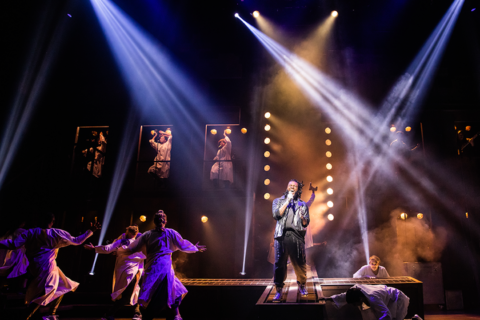
What’s the buzz? ‘Jesus Christ Superstar’ at National Theatre marks homecoming for Virginia native

Roger Corman, Hollywood mentor and ‘King of the Bs,’ dies at 98
Recommended.

'A thing of beauty': 25 years later, Ted Leonsis reflects on Capitals ownership

Loudoun Farm Tour begins Saturday, now with free shuttle buses

'Move away from the Ticketmaster monopoly': All Things Go ticketing nightmare leaves eager fans empty-handed
Related categories:.

Rainbow Book List Committee
To select from the year’s publications and prepare an annual annotated bibliography of books displaying appealing literary quality that relate to the LGBTQIA+ experience and are recommended for young readers from birth through age 18.
Displaying active committee roster as of 05/13/2024. Last retrieved on 05/13/2024. Refresh now .
The Rainbow Book List Committee creates an annual book list of recommended LGBTQIA+ fiction and nonfiction titles for young readers from birth through age 18. Books on the final bibliography are published within the assigned calendar year or between July 1 and December 31 of the previous calendar year.
We invite recommendations for this bibliography from anyone prior to September 30 of each year. A short statement explaining the book's merit should accompany the recommendation. Titles for consideration from jury members are to be submitted by October 31.
Titles under consideration and information about the bibliography can be found on the Rainbow Book List website .
Please use the Contact and Suggestions tabs on the committee website to send questions or your title recommendations to the committee.
The committee consists of eight to twelve members (jurors) and is led by a chair. The committee will have a liaison from the RRT Executive Board.
Chair and Jurors begin their terms following the conclusion of ALA's LibLearnX. Rainbow Book List Jurors serve two years, after which they must complete a one-year hiatus before being eligible for another appointment to the committee.
The Chair serves a one-year term and assumes all leadership duties of the committee.
When possible, appointments will take into consideration geographical regions of the United States, racial and ethnic groups, types of libraries, and gender.
The committee consists of members appointed by the RRT Board, serving one-year terms with the option to renew for a second year. Each annual cycle will be led by an appointed chair. The committee has the support of a liaison from the RRT Board and an ALA Staff Liaison.
The Rainbow Book List Committee was created as a grass-roots effort in 2007 to provide young people with books that reflect LGBTQIA+ individuals, groups, and experiences. Although many more books with LGBTQIA+ content are available to this audience than in the past, many of these are not identified as such, necessitating such a bibliography. The Rainbow Book List Committee was originally a Social Responsibilities Round Table (SRRT) task force but became affiliated also with Rainbow Round Table (formerly the Gay, Lesbian, Bisexual, and Transgender Round Table, GLBTRT) during the ALA Midwinter Meeting 2009.
RRT Membership Meeting Documents, 2009 ALA Annual Conference:
- Membership Meeting Minutes: Not Submitted By Secretary
- Membership Meeting Agenda: [pdf: 68kb]
Project Proposal Documents:
- Amendment to RRT Bylaws for 2009 ALA Annual Conference, RRT Membership Meeting
- 2009 Committee Procedures: [pdf: 82kb]
The Rainbow Book List Committee was officially voted a virtual committee by the RRT Executive Board at its meeting September 2018.
Requirements/Duties of Rainbow Book List Committee Jury Members
- Must be a member of the American Library Association and the Rainbow Round Table.
- Maintain knowledge of current LGBTQIA+ publishing, actively seeking appropriate books.
- Read and critically evaluate current LGBTQIA+ books.
- Submit LGBTQIA+ books to consider throughout the year.
- Participate regularly in jury discussions of LGBTQIA+ books.
- Regularly read books nominated for the Rainbow Book List bibliography.
- Communicate book reviews and other pertinent information regarding LGBTQIA+ books with other jury members during the year.
- Follow the rules and procedures of the Rainbow Book List Committee and meet the deadlines established by the jury chair.
- Perform other duties that the jury chair and chair-elect deem necessary.
Requirements and Duties of the Rainbow Book List Committee Liaison
- Maintain the Rainbow Book List blog.
- Help with publicity.
- Request preview copies of titles under consideration from publishers and authors on behalf of the Rainbow Book List and Stonewall Children’s and Young Adult Committee jurors.
Requirements and Duties of the Rainbow Book List Committee Chair
In addition to the requirements and duties of jurors, the Chair has the following responsibilities:
- Offer the Rainbow Round Table Chair-elect/Chair recommendations for committee members who will maintain a balance of geographical regions of the United States, racial and ethnic groups, and types of libraries. Every effort will be made to maintain gender parity.
- Ensure that the Rainbow Book List Committee complies with policies and procedures.
- Maintain an accurate database of all nominated titles.
- Communicate frequently with jury members regarding nominated books.
- Report to the Office of Diversity, Literacy, and Outreach Services (ODLOS), and RRT as needed.
- Provide publicity as needed regarding the Rainbow Book List Committee and its bibliographies.
- Facilitate Committee discussion.
- Provide the final bibliography to publishers.
- Attend to all other business matters and duties as deemed necessary by the Rainbow Book List Committee.
Eligibility of Books
Books considered for the bibliography must have been published within the assigned calendar year or between July 1 and December 31 of the previous calendar year. Eligibility of books originally published outside the United States will be determined according to the original publication dates in the United States. Books must be distributed in the United States during the period of eligibility to be considered for the list. Revisions of previously published titles will be considered if the revision is to such an extent as to make the book substantially different from the previous edition. Any book removed from consideration the previous year is eligible for consideration during the following year if it meets the eligibility requirements. Any book considered and discussed during final deliberations will be ineligible for nomination during the following year.
Both fiction and nonfiction shall have readable text and format appealing to children and/or teens. Although the list attempts to present a variety of reading tastes and levels, no effort will be made to balance the list according to subject, area of interest, age, or genre. Annotations for the bibliography are written so as to attract the young reader.
Bibliography Selection Process
Committee jury members will regularly recommend titles, discuss recommendations, and participate in straw polls virtually.This non-binding vote indicates the status of books within six weeks before the ALA's LLX. The results of this straw poll will be compiled and disseminated to the jury members of the Committee within a week.
After the results of the straw poll, a book may be withdrawn by the person who recommended the title. If another Committee jury member wishes to keep that title on the list for discussion, that person must indicate this; otherwise the book is dropped from the recommended titles list.
The final discussion and selection of the bibliography will be conducted within six weeks of LLX. Decisions will be reached by consensus, meaning that each member accepts the decision. If the group cannot come to consensus, the decision will be made with no more than one person dissenting. For a book to be put on the list, at least five jury members must have read the book and agreed to its inclusion. Consideration for the final list is not based on a certain number of fiction or nonfiction titles, nor is it based on a certain number of titles for different age groups. Only jury members participating in all discussions about the book will be allowed to vote on a specific title. Jury members can vote only on books they have read in their entirety. The top four or five and the top ten books are also selected for purposes of highlighting exceptional titles for publicity. After the final discussion and selection, titles are then annotated by the committee.
Announcement of the Rainbow Book List Bibliography
The committee will provide the ALA Public Information Office with the final list of selected titles in the form of a press release. The press release will be posted on the Rainbow Book List website and made available to RRT and SRRT for their websites and other communication channels, and provided to various sources such as magazines directed toward teens, LGBTQIA+ issues, and library professionals and discussion groups on the Internet. The final bibliography, or a portion of it, will also appear in a spring issue of Booklist .
Revision History
- 2018 October Amendments - Amendments to further align procedures with a board vote to make the OTR a virtual committee, board terms, and adoption of the term LGBTQIA+.
- 2014 July Amendments - Amendments to further align procedures with the GLBTRT Bylaws, the GLBTRT Leadership Responsibilities document and a board vote about the use of the word nomination at the March 2014 board meeting.
- 2012 July Amendments to Procedures - Alignment of procedures with the GLBTRT Bylaws adopted 2011 ALA Election and the GLBTRT Leadership Responsibilities document adopted on 7 March 2012 by GLBTRT Steering Committee.
Serving on a Rainbow Round Table committee requires membership in ALA and RRT. Learn more by visiting our membership page . To volunteer for a committee, visit our volunteer form page .
Share This Page
University Libraries Hosts Montclair Literary Festival Book Talk: Bilingual Lives, American Stories
Posted in: Homepage Features

On April 27, 2024, as part of the Montclair Literary Festival, University Libraries hosted a book talk at the Alumni Green Overlook in Sprague Library. It was led by Cleyvis Natera, author of Neruda on the Park , which was awarded a Silver Medal by the International Latino Book Awards for Best First Book of Fiction in 2023.
Natera, Deborah Paredez, chair of the creative writing program at Columbia University and author of American Diva , and Angie Cruz, award-winning author of How Not To Drown in A Glass of Water , a work recognized by the New York Times 100 Notable Books of 2022, delved into their multicultural and bilingual backgrounds and how they aided in crafting powerful and moving narratives.
After the insightful discussion, all three authors chatted with the over 40 attendees and signed copies of their books, provided by the Montclair’s indie bookstore Watchung Booksellers .

The New York Public Library
Digital collections.
- Collections
- Current image Preserve zoom level
- View as Book
Green Book: 1962: Guide for Travel & Vacations
- Type of Resource text
- Genre Guidebooks
- Date Issued 1962
- Division Schomburg Center for Research in Black Culture, Manuscripts, Archives and Rare Books Division
- Publisher Victor H. Green & Co. (Publisher : New York, N.Y.)
More Details Cite This Item
Library division & collection with this item:
Library division schomburg center for research in black culture, manuscripts, archives and rare books division.

COLLECTION The Green Book
SUB-COLLECTION Travelers' green book
View this item elsewhere:
Cite this item.
The Green Book
Travelers' green book
Item timeline of events
- 1962: Issued
- 2015: Digitized
- 2024: Found by you!
Schomburg Center for Research in Black Culture, Manuscripts, Archives and Rare Books Division, The New York Public Library. "Green Book: 1962" The New York Public Library Digital Collections . 1962. https://digitalcollections.nypl.org/items/786175a0-942e-0132-97b0-58d385a7bbd0
Chicago/Turabian Format
Schomburg Center for Research in Black Culture, Manuscripts, Archives and Rare Books Division, The New York Public Library. "Green Book: 1962" New York Public Library Digital Collections. Accessed May 13, 2024. https://digitalcollections.nypl.org/items/786175a0-942e-0132-97b0-58d385a7bbd0
What Are You Working On?
NYPL is always looking for ways to promote how researchers, writers, artists, and patrons are using the libary's materials. We'd love to hear what you're working on!
Schomburg Center for Research in Black Culture, Manuscripts, Archives and Rare Books Division, The New York Public Library. (1962). Green Book: 1962 Retrieved from https://digitalcollections.nypl.org/items/786175a0-942e-0132-97b0-58d385a7bbd0
Wikipedia Citation
<ref name=NYPL>{{cite web | url=https://digitalcollections.nypl.org/items/786175a0-942e-0132-97b0-58d385a7bbd0 | title= (text) Green Book: 1962, (1962) |author=Digital Collections, The New York Public Library |accessdate=May 13, 2024 |publisher=The New York Public Library, Astor, Lenox, and Tilden Foundations}}</ref>
- President and Leadership
- Space Rental
- Careers at NYPL
- Resources for Teachers
- E-Newsletters
- Media Center
- Connect with NYPL
- Mobile Apps
- Reserve a PC
- The Library Shop
- Privacy Policy
- Rules and Regulations
- Using the Internet
- Website Terms and Conditions
- Gifts of Materials to NYPL
© The New York Public Library, 2024
The New York Public Library is a 501(c)(3) | EIN 13-1887440
- Yekaterinburg
- Novosibirsk
- Vladivostok

- Tours to Russia
- Practicalities
- Russia in Lists
Rusmania • Deep into Russia
Out of the Centre
Savvino-storozhevsky monastery and museum.

Zvenigorod's most famous sight is the Savvino-Storozhevsky Monastery, which was founded in 1398 by the monk Savva from the Troitse-Sergieva Lavra, at the invitation and with the support of Prince Yury Dmitrievich of Zvenigorod. Savva was later canonised as St Sabbas (Savva) of Storozhev. The monastery late flourished under the reign of Tsar Alexis, who chose the monastery as his family church and often went on pilgrimage there and made lots of donations to it. Most of the monastery’s buildings date from this time. The monastery is heavily fortified with thick walls and six towers, the most impressive of which is the Krasny Tower which also serves as the eastern entrance. The monastery was closed in 1918 and only reopened in 1995. In 1998 Patriarch Alexius II took part in a service to return the relics of St Sabbas to the monastery. Today the monastery has the status of a stauropegic monastery, which is second in status to a lavra. In addition to being a working monastery, it also holds the Zvenigorod Historical, Architectural and Art Museum.
Belfry and Neighbouring Churches

Located near the main entrance is the monastery's belfry which is perhaps the calling card of the monastery due to its uniqueness. It was built in the 1650s and the St Sergius of Radonezh’s Church was opened on the middle tier in the mid-17th century, although it was originally dedicated to the Trinity. The belfry's 35-tonne Great Bladgovestny Bell fell in 1941 and was only restored and returned in 2003. Attached to the belfry is a large refectory and the Transfiguration Church, both of which were built on the orders of Tsar Alexis in the 1650s.

To the left of the belfry is another, smaller, refectory which is attached to the Trinity Gate-Church, which was also constructed in the 1650s on the orders of Tsar Alexis who made it his own family church. The church is elaborately decorated with colourful trims and underneath the archway is a beautiful 19th century fresco.
Nativity of Virgin Mary Cathedral

The Nativity of Virgin Mary Cathedral is the oldest building in the monastery and among the oldest buildings in the Moscow Region. It was built between 1404 and 1405 during the lifetime of St Sabbas and using the funds of Prince Yury of Zvenigorod. The white-stone cathedral is a standard four-pillar design with a single golden dome. After the death of St Sabbas he was interred in the cathedral and a new altar dedicated to him was added.

Under the reign of Tsar Alexis the cathedral was decorated with frescoes by Stepan Ryazanets, some of which remain today. Tsar Alexis also presented the cathedral with a five-tier iconostasis, the top row of icons have been preserved.
Tsaritsa's Chambers

The Nativity of Virgin Mary Cathedral is located between the Tsaritsa's Chambers of the left and the Palace of Tsar Alexis on the right. The Tsaritsa's Chambers were built in the mid-17th century for the wife of Tsar Alexey - Tsaritsa Maria Ilinichna Miloskavskaya. The design of the building is influenced by the ancient Russian architectural style. Is prettier than the Tsar's chambers opposite, being red in colour with elaborately decorated window frames and entrance.

At present the Tsaritsa's Chambers houses the Zvenigorod Historical, Architectural and Art Museum. Among its displays is an accurate recreation of the interior of a noble lady's chambers including furniture, decorations and a decorated tiled oven, and an exhibition on the history of Zvenigorod and the monastery.
Palace of Tsar Alexis

The Palace of Tsar Alexis was built in the 1650s and is now one of the best surviving examples of non-religious architecture of that era. It was built especially for Tsar Alexis who often visited the monastery on religious pilgrimages. Its most striking feature is its pretty row of nine chimney spouts which resemble towers.

Plan your next trip to Russia
Ready-to-book tours.
Your holiday in Russia starts here. Choose and book your tour to Russia.
REQUEST A CUSTOMISED TRIP
Looking for something unique? Create the trip of your dreams with the help of our experts.

COMMENTS
In 1936 the Green Book was only a local publication for Metropolitan New York, the response for copies was so great it was turned into a national issue in 1937 to cover the United States. ... Library locations Schomburg Center for Research in Black Culture, Manuscripts, Archives and Rare Books Division Topics African Americans-- Travel ...
THE NEGRO MOTORIST GREEN BOOK. guided Black Americans to thousands. of businesses for over thirty years. When the first Green Book was published, the American road was a metaphor for freedom. Yet, in 20th century America, this same road. was a dangerous place for Black citizens. The land was divided by segregation—through policy or through ...
The Green Book was a travel guide published between 1936 and 1966 that listed hotels, restaurants, bars, gas stations, etc. where black travelers would be welcome. NYPL Labs is in the process of extracting the data from the Green Books themselves and welcomes you to explore its contents in new ways. Visualize a trip using the Green Books.
The Negro Motorist Green Book (also, The Negro Travelers' Green Book, or Green-Book) was a guidebook for African American roadtrippers.It was founded by Victor Hugo Green, an African American, New York City postal worker who published it annually from 1936 to 1966.This was during the era of Jim Crow laws, when open and often legally prescribed discrimination against African Americans ...
An annual guidebook for African-American roadtrippers founded and published by New York City mailman Victor Hugo Green from 1936 to 1967. From a New York-focused first edition published in 1936, Green expanded the work to cover much of North America. The Green Book became "the bible of black travel" during the era of Jim Crow laws, when open and often legally prescribed discrimination against ...
Schomburg Treasures: The Green Book. By K Menick, Schomburg Center. March 24, 2015. Schomburg Center for Research in Black Culture. The Negro Motorist Green Book, 1947. " Carry your Green Book with you—you may need it ." The mid-20th Century: a time of freedom and grand opportunities. Ever bigger and faster and cheaper cars allowed an ...
The Green Book Resource Guide is not an exhaustive list of resources. This guide has been curated to include useful primary and secondary content related to better understanding the historical significance of The Green Books. With the introduction of this travel guide in 1936, it has been our idea to give the Negro traveler information that ...
Navigating the Green Book is a digital mapping and archival project funded by the New York Public Library, featuring the work of Paul Beaudoin, Brian Foo, Josh Hadro, and Matt Miller.1 The purpose of Navigating the Green Book is to allow site visitors to explore the data contained in the Negro Motorists' Green Book and similar titles in ways ...
Simms' blue book and national Negro business and professional directory collection Travelguide Hackley & Harrison's hotel and apartment guide for colored travelers: board, rooms, garage accommodations, etc. in 300 cities in the United States and Canada.
"The Travelers' Green Book: 1960" New York Public Library Digital Collections. https://digitalcollections nypl.org. The Green Book, also known as The Negro Motorist Green Book, and later, The Negro Travelers' Green Book, was a travel guide for African Americans, published from 1936 to 1966. The annual guide was designed to show businesses ...
History. Organized in 1979, Friends of the Tom Green County Library, Inc. was established to promote use of the Library and its many services through donations and various projects. The Friends were a motivating force behind the construction of Angelo West Branch Library and have donated substantially to the North Branch Library expansion.
The Green Book (PDF Books and Information) According to the New York Public Library: "The Green Book was a travel guide published between 1936 and 1966 that listed hotels, restaurants, bars, gas stations, etc. where black travelers would be welcome.". The intro to the original edition of the Green Book reads: " With the introduction of this ...
The library holds an indoor book sale during the week of Dickens of a Christmas in December and through the following Christmas on Main Street weekend, with proceeds supporting the library. The June Laurel Festival book sale is held outside or inside the Gmeiner. This sale is organized and ran by the Friends of The Green Free Library.
Movies. Green Book builds a feel-good comedy atop an artifact of shameful segregation. Yikes. The movie is named after guides published for black travelers in segregated America. But its spin is ...
The Negro Travelers' Green Book was a travel guide series published from 1936 to 1964 by Victor H. Green. It was intended to provide African American motorists and tourists with the information necessary to board, dine, and sightsee comfortably and safely during the era of segregation. The custom Google Map at left compiles place marks for ...
The book is now in limbo at the Fishers library — on the "hold" shelf. The popular young adult novel was sent to the adult section for content deemed "not age-appropriate" last month. ... Green asked on social media Monday, "What about my other books and hundreds of other YA titles? Award-winning classics of YA lit by everyone from Nic Stone ...
The Library of Congress named 25 recordings as audio treasures worthy of preservation for all time based on their cultural, historical or aesthetic importance in the nation's recorded sound ...
The Poison Book Project is a project of the Winterthur Museum, Garden and Library and the University of Delaware to identify and catalog books known to contain poisonous substances, particularly arsenic in Paris green pigments. It was started in 2019 when Winterthur staff members Melissa Tedone and Rosie Grayburn identified a book containing ...
The Rainbow Book List Committee was created as a grass-roots effort in 2007 to provide young people with books that reflect LGBTQIA+ individuals, groups, and experiences. Although many more books with LGBTQIA+ content are available to this audience than in the past, many of these are not identified as such, necessitating such a bibliography.
On April 27, 2024, as part of the Montclair Literary Festival, University Libraries hosted a book talk at the Alumni Green Overlook in Sprague Library. It was led by Cleyvis Natera, author of Neruda on the Park, which was awarded a Silver Medal by the International Latino Book Awards for Best First Book of Fiction in 2023.
MENASHA, Wis. (WFRV) - Menasha's Public Library will soon be making a temporary move across town. As the library undergoes renovations for the rest of the year, officials will mov…
Travelers' green book. Dates / Origin. Date Issued: 1966. Publisher: Victor H. Green & Co. Library locations. Schomburg Center for Research in Black Culture, Manuscripts, Archives and Rare Books Division. Shelf locator: Sc Rare Per-T (Travelers' green book) Topics. African Americans -- Travel -- Periodicals.
In 1938, it was granted town status. [citation needed]Administrative and municipal status. Within the framework of administrative divisions, it is incorporated as Elektrostal City Under Oblast Jurisdiction—an administrative unit with the status equal to that of the districts. As a municipal division, Elektrostal City Under Oblast Jurisdiction is incorporated as Elektrostal Urban Okrug.
I have a background in high-performance remodeling, additions, and new construction, and I've read a few books on the science, like Pretty Good House and Towards a Zero Energy Home, as well as some architectural books like Get Your House Right, and some Francis DK Ching books, but I haven't found a good book on drawing floor plans specifically.
The Franklin County school system plans to eliminate all of its school librarian positions in the 2024-25 school year to save money. Media assistants would work the libraries.
The Green Book. Travelers' green book. Dates / Origin Date Issued: 1962 Publisher: Victor H. Green & Co. Library locations Schomburg Center for Research in Black Culture, Manuscripts, Archives and Rare Books Division Shelf locator: Sc Rare Per-T (Travelers' green book) Topics African Americans-- Travel-- Periodicals Automobile travel-- Guidebooks
Zvenigorod's most famous sight is the Savvino-Storozhevsky Monastery, which was founded in 1398 by the monk Savva from the Troitse-Sergieva Lavra, at the invitation and with the support of Prince Yury Dmitrievich of Zvenigorod. Savva was later canonised as St Sabbas (Savva) of Storozhev. The monastery late flourished under the reign of Tsar ...
Elektrostal. Elektrostal ( Russian: Электроста́ль) is a city in Moscow Oblast, Russia. It is 58 kilometers (36 mi) east of Moscow. As of 2010, 155,196 people lived there.